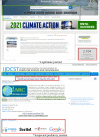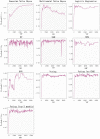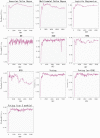An open automation system for predatory journal detection
- PMID: 36806308
- PMCID: PMC9940686
- DOI: 10.1038/s41598-023-30176-z
An open automation system for predatory journal detection
Erratum in
-
Author Correction: An open automation system for predatory journal detection.Sci Rep. 2023 May 8;13(1):7458. doi: 10.1038/s41598-023-34493-1. Sci Rep. 2023. PMID: 37156833 Free PMC article. No abstract available.
Abstract
The growing number of online open-access journals promotes academic exchanges, but the prevalence of predatory journals is undermining the scholarly reporting process. Data collection, feature extraction, and model prediction are common steps in tools designed to distinguish between legitimate and predatory academic journals and publisher websites. The authors include them in their proposed academic journal predatory checking (AJPC) system based on machine learning methods. The AJPC data collection process extracts 833 blacklists and 1213 whitelists information from websites to be used for identifying words and phrases that might indicate the presence of predatory journals. Feature extraction is used to identify words and terms that help detect predatory websites, and the system's prediction stage uses eight classification algorithms to distinguish between potentially predatory and legitimate journals. We found that enhancing the classification efficiency of the bag of words model and TF-IDF algorithm with diff scores (a measure of differences in specific word frequencies between journals) can assist in identifying predatory journal feature words. Results from performance tests suggest that our system works as well as or better than those currently being used to identify suspect publishers and publications. The open system only provides reference results rather than absolute opinions and accepts user inquiries and feedback to update the system and optimize performance.
© 2023. The Author(s).
Conflict of interest statement
The authors declare that they have no known competing financial interests or personal relationships that could have appeared to influence the work reported in this paper.
Figures










Similar articles
-
Blacklists and Whitelists To Tackle Predatory Publishing: a Cross-Sectional Comparison and Thematic Analysis.mBio. 2019 Jun 4;10(3):e00411-19. doi: 10.1128/mBio.00411-19. mBio. 2019. PMID: 31164459 Free PMC article.
-
A credit-like rating system to determine the legitimacy of scientific journals and publishers.Scientometrics. 2021;126(10):8589-8616. doi: 10.1007/s11192-021-04118-3. Epub 2021 Aug 18. Scientometrics. 2021. PMID: 34421155 Free PMC article.
-
Avoiding predatory publishing for early career neurosurgeons: what should you know before you submit?Acta Neurochir (Wien). 2021 Jan;163(1):1-8. doi: 10.1007/s00701-020-04546-9. Epub 2020 Aug 26. Acta Neurochir (Wien). 2021. PMID: 32845360 Review.
-
An artificial intelligence tool misclassifies sport science journals as predatory.J Sci Med Sport. 2024 Apr;27(4):266-269. doi: 10.1016/j.jsams.2023.12.006. Epub 2023 Dec 20. J Sci Med Sport. 2024. PMID: 38158321
-
Ethical issues in publishing in predatory journals.Biochem Med (Zagreb). 2017 Jun 15;27(2):279-284. doi: 10.11613/BM.2017.030. Biochem Med (Zagreb). 2017. PMID: 28694719 Free PMC article. Review.
Cited by
-
Sinding-Larsen-Johansson disease. Clinical features, imaging findings, conservative treatments and research perspectives: a scoping review.PeerJ. 2024 Sep 25;12:e17996. doi: 10.7717/peerj.17996. eCollection 2024. PeerJ. 2024. PMID: 39346060 Free PMC article.
-
Benchmarking AI chatbots: assessing their accuracy in identifying hijacked medical journals.Diagnosis (Berl). 2025 May 22. doi: 10.1515/dx-2025-0043. Online ahead of print. Diagnosis (Berl). 2025. PMID: 40420640
-
How To Cope With Predatory Journals.J Korean Med Sci. 2025 Jan 13;40(2):e78. doi: 10.3346/jkms.2025.40.e78. J Korean Med Sci. 2025. PMID: 39807007 Free PMC article. Review.
-
[Predatory journals: What are they and how to avoid them?].Rev Med Inst Mex Seguro Soc. 2024 Jan 8;62(1):1-8. doi: 10.5281/zenodo.10278149. Rev Med Inst Mex Seguro Soc. 2024. PMID: 39110929 Free PMC article. Spanish.
References
-
- Berger, M. Everything you ever wanted to know about predatory publishing but were afraid to ask. In ACRL, Baltimore, Maryland (2017).
-
- Nicoll LH, Chinn PL. Caught in the trap: The allure of deceptive publishers. Nurse Author Editor. 2015;4:1.
Grants and funding
- FWKQJ201909/High-level Talent Research Project at Fuzhou University of International Studies and Trade
- 108-2511-H-009-009-MY3/Ministry of Science and Technology, Taiwan
- 108-2511-H-009-009-MY3/Ministry of Science and Technology, Taiwan
- 108-2511-H-009-009-MY3/Ministry of Science and Technology, Taiwan
- 108-2511-H-009-009-MY3/Ministry of Science and Technology, Taiwan
LinkOut - more resources
Full Text Sources
Miscellaneous

